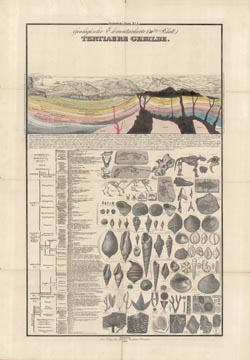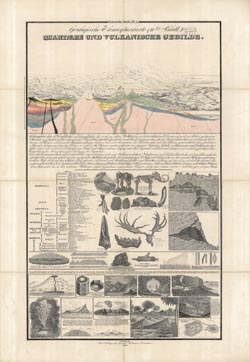Elementary Geology in the 1830s
 |
 |
 |
| 'Geologische Elementarkarte' (plates 3-5), lithographed by H Klöpfel for Im Verlage des Landes - Industrie - Comptoirs, Weimar, 1838. LDGSL/986. |
These three illustrated sheets from the archive entitled 'Geologische Elementarkarte' (1838) are probably from an original set of six. Clearly devised to be seen together, at the at the top of each is a continuous ideal section of the Earth’s crust intended to show geological time in a linear fashion. Underneath are detailed lithographs of fossils, views and other geological images arranged according to the time period from which they originated.
Not much is known about the three plates, other than that they were in the possession of George Bellas Greenough, and formed part of the bequest given to the Society in 1856. The plates still bear Greenough's original labels on which he states that the contents had been taken without acknowledgement from William Buckland's 'Bridgewater Treatise' [Geology and mineralogy considered with reference to natural theology, published in 1836]. Whilst the striking top section and overall concept is obviously based on Buckland's section from ‘Bridgewater Treatise’ (itself copied from the work of Thomas Webster), the publishers, Im Verlage des Landes-Industrie-Comptoirs, have expanded the imagery to include a number of contemporary works from other leading scientists of the day including Louis Agassiz (1807-1873), Charles Lyell (1797-1875) and Georges Cuvier (1769-1832). Hence the plates describe what was known of the subject at the time of publication – a lesson in elementary geology if you like.

|
'Ideal section of a portion of the Earth’s Crust, intended to shew the order of deposition of the stratified rocks, with their relations to the unstratified rocks’, from William Buckland's, Geology and mineralogy considered with reference to natural theology, London: William Pickering, 1836. Click to enlarge.
|
To see the sheets in more detail, click on each plate.